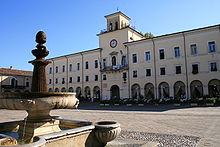Cervia
| Cervia | ||
|---|---|---|

|
|
|
| Country | Italy | |
| region | Emilia-Romagna | |
| province | Ravenna (RA) | |
| Local name | Zirvia | |
| Coordinates | 44 ° 15 ′ N , 12 ° 22 ′ E | |
| height | 3 m slm | |
| surface | 82 km² | |
| Residents | 28,789 (Dec. 31, 2019) | |
| Population density | 351 inhabitants / km² | |
| Factions | see districts | |
| Post Code | 48015, 48016 | |
| prefix | 0544 | |
| ISTAT number | 039007 | |
| Popular name | Cervesi | |
| Patron saint | San Paterniano | |
| Website | www.comunecervia.it | |
Cervia is a town on the Adriatic Sea in the province of Ravenna in Italy with 28,789 inhabitants (as of December 31, 2019). Your previous name was Ficocle ( Greek for "place of algae").
geography
In the dialect, Cervia is called Žìria , the inhabitants are called Cervesi . According to a legend, the name Cervia comes from the deer (Italian cervo ) that knelt down in the forest in front of the Archbishop of Lodi . It is more likely that Cervia comes from the acervi , the heaps of salt in the saline. The legend can still be found in the city coat of arms, represented by a kneeling stag.
Districts
The districts are: Cannuzzo, Castiglione di Cervia (in contrast to the neighboring Castiglione di Ravenna ), Milano Marittima , Montaletto, Pinarella (after the pine tree), Pisignano, Savio (after the river of the same name), Tagliata, Terme and Villa Inferno (from the Latin infer 'below') with the district of Sant'Andrea di Villa Inferno. The Cervia military airfield is located near Pisignano .
history
The original settlement in the middle of the salt pans was given up in 1697 for health and climatic reasons and was replaced by Pope Innocent XII. replaced by a new establishment closer to the sea. The city center, which is connected to the port by a canal, still has the rectangular plan of a planned city in the Renaissance style . From 1463 to 1509 Cervia was Venetian , from 1509 to 1859 - with the exception of the Napoleonic period - part of the Papal States . In 1884 the place was connected with Ravenna , in 1889 with Rimini by rail.
Because of the salt pans, Cervia was highly competitive, especially in the Middle Ages . That the place was economically successful can be seen from a quote from Cardinal Ostiense (ruler of Bologna and Romagna ): “ We get more out of the small town of Cervia than from all of Romagna. "
From 1911 the seaside resort of Milano Marittima was built in a pine grove north of it . The southern seaside resorts of Pinarella and Tagliata were added later . In 1986 the diocese was merged with that of Ravenna under the direction of Ersilio Tonini .
Economy and Infrastructure
Salt pans
The salt obtained by Cervia is considered one of the best in Italy because it is particularly pure: the sodium chloride content is over 97%, making it less bitter than other salts. The salt pans had long been in papal possession, and it was customary for the pope to receive the first salt of the new "harvest" (the sale fiore ) . Every year (usually on the first weekend in September) the “ Sapore di Sale (taste of salt)” salt festival takes place in Piazzale Salinari . On this occasion there are daily guided tours through the salt pans on foot or by boat.
Road network
The rectangular old town is connected to the beach by Viale Roma , which also serves as an evening promenade. Via dei Mille runs parallel to it from the train station to the Grand Hotel and on the other side extends the Piazza Andrea Costa , where the weekly market also takes place. These three main axes are crossed by streets running parallel to the beach, which often change names in their course, e.g. B. Via Cristoforo Colombo becomes Viale Italia .
Sports
Since 2017, a long-distance triathlon (3.86 km swimming, 180.2 km cycling and 42.195 km running) has been held here in September with Ironman Italy .
Attractions
War cemetery
After the Second World War, there was a large German military cemetery in Cervia, but it was closed when the fallen soldiers were put together in the central Futapass military cemetery . To commemorate the disbanded cemetery, the Volksbund Deutsche Kriegsgräberfürsorge has placed the memorial stones of the troops that were preserved when the dead were transferred in the cervia room of the crypt.
- Cathedral from 1699
- Bishop's Palace (17th century)
- Town hall (17th century)
- "San Michele" tower, built in 1691, formerly a guard and defense tower, today the city library
- Open-air museum "Saline Camillone" (every two weeks demonstrations of how the salt was "harvested" in the past)
- Salt magazines Torre and Darsena, built in 1712
- Church of the Suffragio with a 13th century wooden crucifix
- City Theater (1860)
- Parish Church of San Stefano (977) in Pisignano
Twin cities
-
 Jelenia Góra in Lower Silesia (Poland)
Jelenia Góra in Lower Silesia (Poland) -
 Maó on Menorca (Spain)
Maó on Menorca (Spain) -
 Aalen in Baden-Württemberg (Germany)
Aalen in Baden-Württemberg (Germany)
Personalities
- Tolmino Baldassarri , writer and translator
- Alessandro Bianchi , soccer player
- Lino Grassi (* 1931), racing cyclist
- Giovanni Guareschi , journalist, writer
- Tonino Guerra , writer, director
- Bruno Casanova , motorcycle racer
- Lallo Gori , film music composer
Web links
Individual evidence
- ↑ Statistiche demografiche ISTAT. Monthly population statistics of the Istituto Nazionale di Statistica , as of December 31 of 2019.


